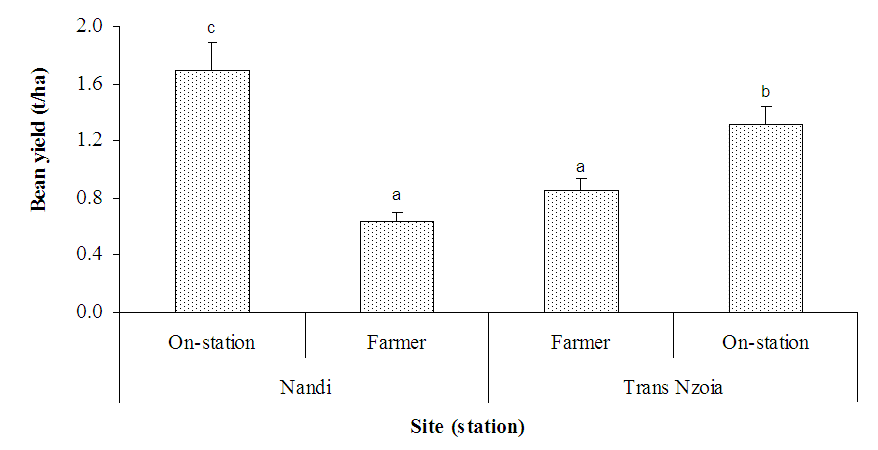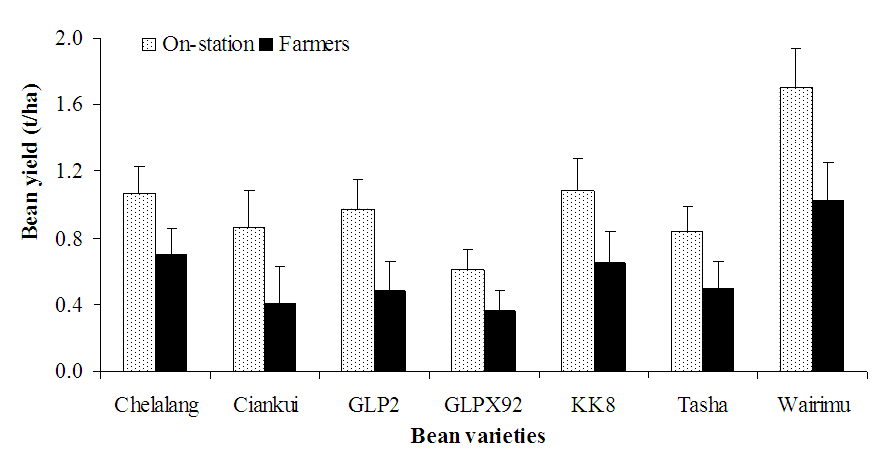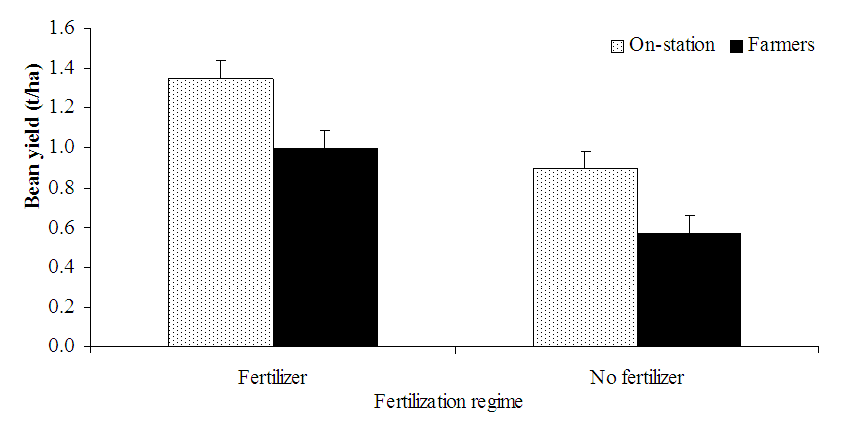-
Paper Information
- Paper Submission
-
Journal Information
- About This Journal
- Editorial Board
- Current Issue
- Archive
- Author Guidelines
- Contact Us
International Journal of Agriculture and Forestry
p-ISSN: 2165-882X e-ISSN: 2165-8846
2020; 10(5): 109-114
doi:10.5923/j.ijaf.20201005.01
Received: Jul. 16, 2020; Accepted: Nov. 19, 2020; Published: Dec. 15, 2020

Onsite, Bean Variety and Fertilization Regime on Bean Yields in Kenya
Joseph Barkutwo1, Mary Koech-Kifuko1, Keziah Ndungu-Magiroi1, Morgan Mutoko1, Margaret Kamidi1, Japhet Wanyama1, Elizabeth Wanjekeche1, Victor Ouma1, Joseph Miriti2, David Nyongesa2, Cyrus Githunguri2, Elias Thuranira2, Anthony Esilaba3, Michael Okoti3, Wasilwa Lusike3
1Kenya Agricultural and Livestock Research Organization (KALRO)-Food Crops Research Institute, Kitale, Kitale, Kenya
2Food Crops Research Institute, KALRO –NARL, Kabete, Nairobi, Kenya
3KALRO Headquarters, Nairobi, Kenya
Correspondence to: Joseph Barkutwo, Kenya Agricultural and Livestock Research Organization (KALRO)-Food Crops Research Institute, Kitale, Kitale, Kenya.
| Email: |  |
Copyright © 2020 The Author(s). Published by Scientific & Academic Publishing.
This work is licensed under the Creative Commons Attribution International License (CC BY).
http://creativecommons.org/licenses/by/4.0/

Low yields of common bean (Phaseolus vulgaris L) in developing countries of the Sub Saharan Africa relate to suite of factors including soil fertility at the planting sites, bean varieties and fertilization. Management strategies should aim at establishing a combination of these factors that would ultimately result in improved common bean yields. In this study, a field experiment was conducted in Kenya during the long rainy season to establish the effects of planting sites, bean varieties and fertilization on bean yield. The experiments consisted of four sites (Nandi, Baraton, KALRO and Trans-Nzoia), seven bean varieties (Chelalang, Ciankui, Tasha, GLPX92, Rose Coco (GLP2), KK8 and Wairimu [GLP 585]) and two fertilization regime (fertilization and no fertilization) in a factorial experiment replicated four times. On-site and farmers field, Wairimu had the highest yield followed by KK8 while the lowest yield was variety GLPX92. Application of fertilizer improved the bean yield significant over and above yield without fertilizers under both on-station and farmers conditions. Results showed that the grain yields were significantly (P < 0.05) influenced by site, bean variety and fertilization. Results demonstrated that some bean varieties responded more to fertilizer application and with good agronomic management, which they are likely to contribute to food security in the region.
Keywords: Common Bean, Varieties, Yield, Seasons, Sites
Cite this paper: Joseph Barkutwo, Mary Koech-Kifuko, Keziah Ndungu-Magiroi, Morgan Mutoko, Margaret Kamidi, Japhet Wanyama, Elizabeth Wanjekeche, Victor Ouma, Joseph Miriti, David Nyongesa, Cyrus Githunguri, Elias Thuranira, Anthony Esilaba, Michael Okoti, Wasilwa Lusike, Onsite, Bean Variety and Fertilization Regime on Bean Yields in Kenya, International Journal of Agriculture and Forestry, Vol. 10 No. 5, 2020, pp. 109-114. doi: 10.5923/j.ijaf.20201005.01.
Article Outline
1. Introduction
- Common bean (Phaseolus vulgaris L.), remains an important grain and vegetable legume, where it provide protein, micronutrients (Calcium, iron, magnesium, phosphorus and potassium), complex carbohydrates (62%), soluble fiber (15%) as well as folate and hydrolysate [8,6]. The crop is widely dispersed in almost all regions of the world [5,16]. In the temperate regions, the season allows up to 120 days of frost-free growth and in the tropical highland regions it grows where the ambient temperatures is less than 30C [9,20]. In 2019, 28 million metric tones of common bean was produced worldwide [10,23]. The crop is grown in over 12 million hectares and feeds more than 500 million people in Latin America and Africa alone [21].In the African Continent, common bean was introduced over 100 years ago from Central and South America [2]. Not-withstanding its introduction in Africa, common bean is among the most essential grain legumes in the diet of most Africans [4], contributing up to 57% of recommended dietary protein and 23% of energy to the nutrition [1,18]. In the Sub-Saharan Africa, common bean is utilized as an alternative source of protein, calories, and trace nutrients to individuals who cannot afford more expensive animal sources of nutrition [19,22]. Kenya is a leading producer of common bean in East Africa region with 300,000-500,000 hectares of land under the crop. Production of common bean in the Kenya ranges between 300,000–500,000 hectares producing about 40,000–150,000 metric tones/year [14]. It is grown in almost all areas in Kenya where its growth is characterized by a large number of small-holdings of no more than one ha. per household, mainly for subsistence with approximately 40% of production for commercial purposes [15]. There are basically six to eight varieties with different expected yields including Chelalang (840-980 kg/hectare), Red Haricot (GLP585) "Wairimu" (870-1110 kg/hectare) Tasha (625-870 kg/hactare), Ciankui (625-825 kg/hectare), KK15 (756-900 kg/hectare), Canadian (613-672 kg/hectare) and Rosecoco (560-935 kg/hectare) (http://www.kalro.org/fileadmin/publications/brochures/beanvariety.pdf). Yields obtained from these varieties are actually lower than the standard yields [15,12]. Indeed, common bean yields on farmers’ fields is on the decline and range from 0.14 to 0.77 t ha-1 with national standing at 0.5 t ha-1. Therefore, understanding the causes of the low yield will guide research for managements measures aimed at increasing the yields of common beans.Common bean production is constrained by low yielding varieties and inadequate technical knowledge among farmers on crop management [17]. Bean varieties developed and released in the recent past with better yields and adaptation have not been widely tested and disseminated in the country. Evaluation of bean varieties at different locations can provide information to farmers and other stakeholders on their suitability for production. Availability of adaptable varieties with high yields can enhance bean production by farmers and total earnings in the agricultural sector on which country’s population is dependent on for their livelihood. There is also ample evidence that fertilization may improve the yield of the crop [3,7]. However, research on the overall influence of varying location, bean variety and fertilization has not been adequately assessed on their influence of common bean yields. Therefore, the objective of this study was to determine the influence of planting sites, bean varieties and fertilization on common bean yields in Kenya.
2. Materials and Methods
2.1. Site Description
- The study was conducted in Trans-Nzoia and Nandi Counties in Kenya. Trans Nzoia County has a unimodal rainfall pattern while Nandi County has a bimodal rainfall pattern. Total annual rainfall recorded during 2016 and 2017 was 1239.6 mm and 1389 mm respectively. Average annual temperatures range between 10°C and 27°C. The region has relatively deep soils, mostly of clay and loam textures [11]. About 70% of the soils are classified as Ferralsols while Acrisols form 20% of the soils. In Nandi County, the total annual rainfall recorded during the 2016 and 2017 was 1422 mm and 1729 mm respectively with temperatures of between 15°C and 25°C. Predominant soils in Trans Nzoia County are Nitic–Humic Acrisols and Humic Ferralsols.
2.2. Experimental Design and Management
- The treatments were arranged in a factorial design with the planting sites, bean varieties and fertilization rates. The experimental unit comprised of five-row plot spaced at 50 cm apart and 10 cm intra-row spacing. Seven bean varieties were tested which included; Chelalang, Ciankui, Tasha, Mwitemania (GLPX92), Rose Coco (GLP2), KK8 which were evaluated alongside a local check Wairimu (GLP585). All fertilizer plots received basal N and P at planting applied as Mavuno fertilizer (10-26-10) by banding at a rate of 40 kg N and 40 kg P2O5 ha-1. Common bean seeds were sown at a spacing of 0.5 m between rows × 0.1 m within the row. Recommended agronomic practices were followed. The on-farm trials were managed by the participating farmers, while collaborating with scientists and agricultural extension staff who monitored and collected the data. The On-station trials were purely research managed.
2.3. Data Collection and Statistical Analysis
- Data on yield was collected on date of harvesting. The generated data was subjected to 4 × 7 × 2 factorial analysis to determine the influence of planting sites, bean varieties and fertilization on P. vulgaris yield using Gensat. Means were separated using least significant difference at 5% level of significance.
3. Results
3.1. Site Variation in Bean Yield
- The common bean yield among planting sites is provided in Figure 1. There were significant differences in bean yield among the planting sites (F = 6.742, df = 3, P = 0.00024). In Nandi County, the bean yield was highest at on-station conditions (1.68 ± 0.20 t/ha) compared to the farmers field conditions (0.63 ± 0.07 t/ha). Similar results were also reported in Trans Nzoia County where common bean yield was highest in on-station condition (1.31 ± 0.12 t/ha) when compared to the farmers field condition (0.85 ± 0.06 t/ha).
 | Figure 1. On site variation on the on the grain yield of beans planted in Nandi and Trans Nzoia Counties during the 2016 and 2017 long rainy seasons |
3.2. Varietal Effect on Bean Grain Yield
- There were significant varietal differences in bean yield during the study at the on-site and among farmers (F =35.445, df = 6, P < 0.01). All bean varieties had higher yields at the onsite compared to yield at the farmers field (t test; P < 0.05). At the on-site and farmers field, Wairimu had the highest yield followed by KK8 while the lowest yield was variety GLPX92.
 | Figure 2. Varietal effect on the grain yield of beans planted in Trans Nzoia County during the 2016 and 2017 long rainy seasons |
3.3. Bean Grain Yield Response to Fertilization
- Figure 3 presents bean grain yield response to fertilizer application during the long rainy seasons at the onsite and farmers’ condition. Application of fertilizer improved the bean yield significant over and above yield without fertilizers under both on-station and farmers conditions.
 | Figure 3. Varietal effect on the grain yield of beans planted in Trans Nzoia County during the 2016 and 2017 long rainy seasons |
3.4. Interactions between Site, Variety and Fertilizer on Bean Yields
- Interaction between site, variety and fertilizer application on common bean yield is provided in Table 1, while Interaction effect between site, bean varieties and fertilization on bean grain yield is shown in Table 2. There was a significant interaction between site, variety and fertilizer application on bean yield (P < 0.05). Highest bean yield occurred under a combination of on-site, Wairimu and KK8 with fertilization (bolded figures), while the lowest yield was obtained based on a combination of Farmers, GLPX92 and Tasha and No fertilizers.
 | Table 1. Interaction effect between variety and fertilizer on bean grain yield under On-station conditions in Trans-Nzoia County |
|
4. Discussion
- The common bean yield on-site station condition in Nandi (1.68 ± 0.20 t/ha) and Trans Nzoia (1.31 ± 0.12 t/ha) Counties were above the Kenyan average bean yield of 0.5 t ha-1 which suggest that the production of common beans in these on-station experimental trial sites occur in soils that are more fertile than other regions on Kenya, perhaps due to the strict conditions observed during field operations and control regime in the experimental stations. However, the values of bean yield at the farmers field in both counties resulted in lower yields than on-station conditions. Moreover, similar range was reported in several parts of Kenya (0.14 to 0.77 t ha-1). The differences in bean yield between the on-site and farmers field could be related to suits of conditions of which improved soil, management regimen, field operations among other could be probable, but further analysis of the differences in bean productivity factors may further elucidate this observation. There were significant varietal differences in bean yield during the study on-site and among farmers. All bean varieties had higher yields at the onsite compared to yield at the farmers’ field. On-site and farmers field, Wairimu had the highest yield followed by KK8 while the lowest yield was variety GLPX92.Bean grain yield response to fertilizer application during the long rainy seasons, clearly indicated that yield was improved through application of fertilizer regardless of the site of planting. Varietal effect exhibited that local check Wairimu is a stable variety and is well suited to different agro ecological while KK8 and GLPX92 if well managed has good potential in Nandi County. It has been demonstrated that Wairimu cause flatulence after consumption and is not preferred by consumers which might hinder adoption [13]. While KK8 performed well under on-station trials, its performance under on-farm trials was not good which was largely attributed to management. KK8 is late maturing and due to logistical problems, this variety was harvested by farmers in most on-farm trials. Low grain yield recorded in GLPX92 was attributed to low germination rate and shattering of mature beans that was observed in this variety. Generally, the interaction between site, variety and fertilizer application significantly affected yields of common bean yield, suggesting that a combination of soil factors, varieties and fertilization practiced will improve production simultaneously.
5. Conclusions
- The need to improve production of common bean should focus on a number of factors. In the present study, the performance of bean varieties varied largely with site, variety and fertilization. Wairimu and GLP 2 variety however recorded an outstanding yield across sites while most varieties recorded lower or similar yield to Wairimu. High yielding bean varieties with more fertilizer response could increase bean production and contribute to the improved food security in the region.
ACKNOWLEDGEMENTS
- The authors are grateful to the Government of Kenya and European Union for funding this project through the Kenya Cereal Enhancement Programme. Finally, the authors are indebted to all farmers who cooperated and allowed the research activities to be carried in their farms. We also thank the field staff both in Nandi and Trans-Nzoia Counties for the assistances in the field work.
 Abstract
Abstract Reference
Reference Full-Text PDF
Full-Text PDF Full-text HTML
Full-text HTML